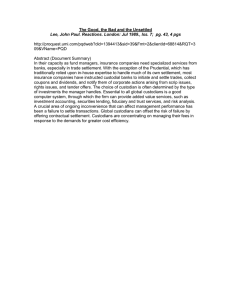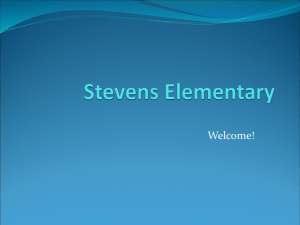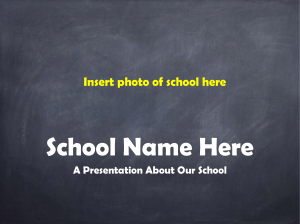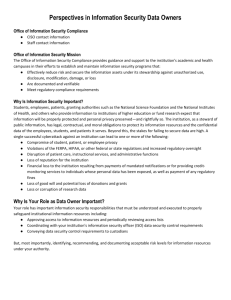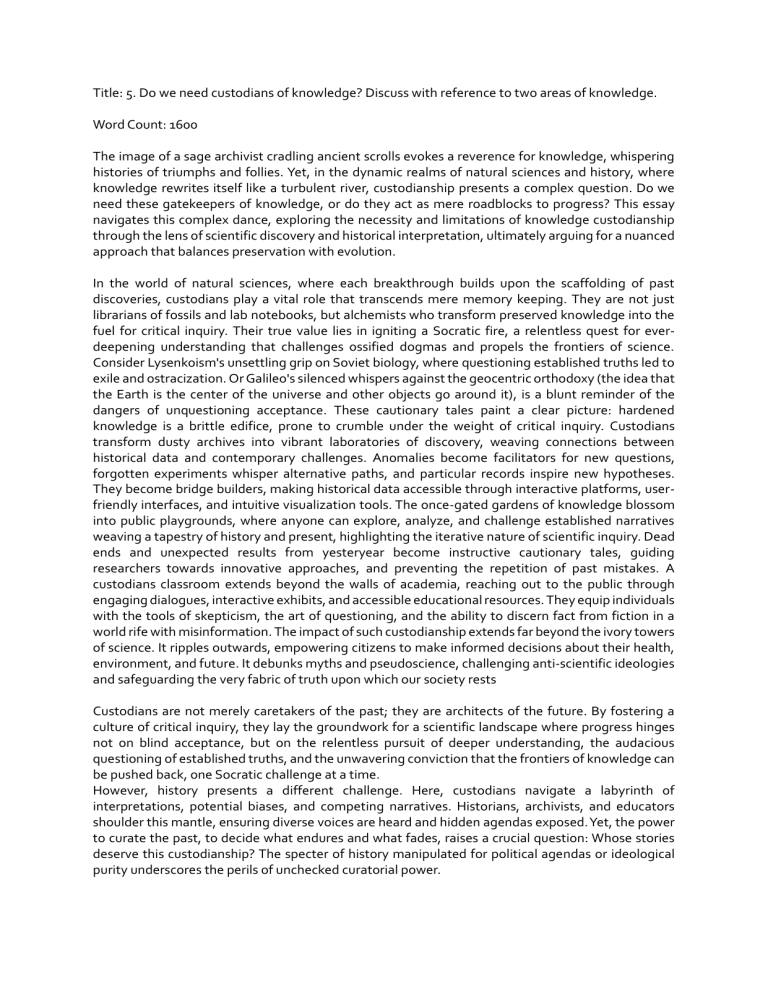
Title: 5. Do we need custodians of knowledge? Discuss with reference to two areas of knowledge. Word Count: 1600 The image of a sage archivist cradling ancient scrolls evokes a reverence for knowledge, whispering histories of triumphs and follies. Yet, in the dynamic realms of natural sciences and history, where knowledge rewrites itself like a turbulent river, custodianship presents a complex question. Do we need these gatekeepers of knowledge, or do they act as mere roadblocks to progress? This essay navigates this complex dance, exploring the necessity and limitations of knowledge custodianship through the lens of scientific discovery and historical interpretation, ultimately arguing for a nuanced approach that balances preservation with evolution. In the world of natural sciences, where each breakthrough builds upon the scaffolding of past discoveries, custodians play a vital role that transcends mere memory keeping. They are not just librarians of fossils and lab notebooks, but alchemists who transform preserved knowledge into the fuel for critical inquiry. Their true value lies in igniting a Socratic fire, a relentless quest for everdeepening understanding that challenges ossified dogmas and propels the frontiers of science. Consider Lysenkoism's unsettling grip on Soviet biology, where questioning established truths led to exile and ostracization. Or Galileo's silenced whispers against the geocentric orthodoxy (the idea that the Earth is the center of the universe and other objects go around it), is a blunt reminder of the dangers of unquestioning acceptance. These cautionary tales paint a clear picture: hardened knowledge is a brittle edifice, prone to crumble under the weight of critical inquiry. Custodians transform dusty archives into vibrant laboratories of discovery, weaving connections between historical data and contemporary challenges. Anomalies become facilitators for new questions, forgotten experiments whisper alternative paths, and particular records inspire new hypotheses. They become bridge builders, making historical data accessible through interactive platforms, userfriendly interfaces, and intuitive visualization tools. The once-gated gardens of knowledge blossom into public playgrounds, where anyone can explore, analyze, and challenge established narratives weaving a tapestry of history and present, highlighting the iterative nature of scientific inquiry. Dead ends and unexpected results from yesteryear become instructive cautionary tales, guiding researchers towards innovative approaches, and preventing the repetition of past mistakes. A custodians classroom extends beyond the walls of academia, reaching out to the public through engaging dialogues, interactive exhibits, and accessible educational resources. They equip individuals with the tools of skepticism, the art of questioning, and the ability to discern fact from fiction in a world rife with misinformation. The impact of such custodianship extends far beyond the ivory towers of science. It ripples outwards, empowering citizens to make informed decisions about their health, environment, and future. It debunks myths and pseudoscience, challenging anti-scientific ideologies and safeguarding the very fabric of truth upon which our society rests Custodians are not merely caretakers of the past; they are architects of the future. By fostering a culture of critical inquiry, they lay the groundwork for a scientific landscape where progress hinges not on blind acceptance, but on the relentless pursuit of deeper understanding, the audacious questioning of established truths, and the unwavering conviction that the frontiers of knowledge can be pushed back, one Socratic challenge at a time. However, history presents a different challenge. Here, custodians navigate a labyrinth of interpretations, potential biases, and competing narratives. Historians, archivists, and educators shoulder this mantle, ensuring diverse voices are heard and hidden agendas exposed. Yet, the power to curate the past, to decide what endures and what fades, raises a crucial question: Whose stories deserve this custodianship? The specter of history manipulated for political agendas or ideological purity underscores the perils of unchecked curatorial power. For centuries, history resided in hallowed halls, guarded by archivists and academics who held the keys to dusty chronicles and whispering parchment. The custodians of time and knowledge, they meticulously preserved and curated the grand narratives of empires and dynasties, ensuring their echoes reverberated through generations. In this static landscape, history was a tapestry woven by privileged hands, its threads occasionally frayed by whispers of dissent, but ultimately remaining an authoritative portrait of the past. However, the 21st century whispers a different tune. From digital town squares to archival revolutions, citizen history movements rise like groundswells, reshaping the terrain of memory. Individuals reclaiming their voices and challenging dominant narratives threaten to dislodge the traditional custodial model from its pedestal. These digital pioneers, armed with smartphones and social media, demand a democratization of the past, one where diverse voices weave not just counterpoints, but entire retellings of history's grand saga. But amidst this exhilarating cruelty lies a hidden danger: the deluge of unfiltered information threatens to flood us in a labyrinth of competing truths. Unverified narratives, cherry-picked evidence, and emotional biases can easily masquerade as historical fact. Witness the echo chambers of social media, where historical revisionism masquerades as truth and confirmation bias drowns out critical thinking. It is here that the role of custodians transcends mere preservation. They must morph into discerning guides, equipping the public with the tools to navigate this intricate labyrinth with discernment. The burden, then, shifts from passive protection to active engagement. No longer gatekeepers of knowledge, custodians become educators, instilling in the public the art of critical source evaluation. Educational initiatives like interactive online platforms and gamified simulations can provide immersive experiences where individuals learn to analyze primary sources, identify potential biases, and assess the credibility of information. Imagine dissecting the diaries of Anne Frank with an interactive tool that unveils the context and hidden meaning behind each carefully inscribed word. Such immersive learning cultivates not just historical knowledge, but the critical thinking skills needed to navigate the digital deluge. Furthermore, responsible reconstruction demands collaboration, not dictation. Citizen history projects become vibrant online hubs where the collective wisdom of the crowd replaces the solitary scholar. Platforms like Wikipedia, with its open-source approach to historical narratives, demonstrate the power of collective knowledge-building, where individuals can contribute, edit, and debate interpretations, ensuring a nuanced and evolving portrait of the past. Imagine a digital forum dedicated to the Civil War, where descendants of Union and Confederate soldiers, alongside amateur historians, and professional academics, collaboratively piece together a richer, more inclusive understanding of this complex conflict. Finally, championing marginalized voices becomes the cornerstone of this new custodial model. Oral history projects, once relegated to academic footnotes, now take center stage. Platforms like the Shoah Foundation's Visual History Archive allow Holocaust survivors to break the silence, their personal testimonies challenging sanitized official records and amplifying previously unheard narratives. Imagine history not as a dusty tomb of pronouncements and dates, but as a vibrant dance floor pulsating with the rhythms of countless voices. Each step echoes a lived experience, each turn a challenge to established narratives. Into this dynamic arena emerge the citizen history movements, their diverse stories, and perspectives a whirlwind challenging the traditional custodians of the past. This burgeoning polyphony presents not a harbinger of chaos, but an invitation to a new dance – one where custodians and citizens co-create a richer, more nuanced understanding of our shared past. Gone are the days of the solitary scholar peering through yellowed parchment, sole guardian of the historical narrative. The internet has thrown open the archive doors, and individuals armed with smartphones and social media become active participants in excavating the past. From meticulously digitized census records to heart-wrenching oral histories recorded on smartphones, the deluge of personal narratives offers invaluable counterpoints to traditional, often skewed, perspectives. The whispers of marginalized communities, silenced for centuries, find their voice, weaving new threads into the tapestry of history. Yet, amidst this exhilarating cacophony lies a hidden obstacle: the labyrinthine nature of unfiltered information. Without critical tools, the dance risks dissolving into a chaotic mosh pit. This is where the role of custodians transforms. They become, not gatekeepers, but agile guides, equipping the public with the skills to navigate the labyrinth with discernment. Imagine history textbooks replaced by interactive online platforms where individuals dissect primary sources like detectives, uncovering biases and piecing together fragments of truth. Picture online forums buzzing with respectful debate, where professional historians and amateur enthusiasts collaboratively reconstruct historical events, each perspective enriching the tapestry of understanding. In this era of citizen history, critical thinking and source evaluation become the essential steps for every dance partner. But the steps of this dance transcend mere analysis. They embrace inclusion and collaboration. Custodians facilitate projects where descendants of opposing sides in historical conflicts, like the Civil War or the Rwandan genocide, come together to weave a more multifaceted understanding of their shared past. Imagine citizen scientists deciphering ancient manuscripts alongside seasoned paleographers, or local communities documenting their heritage with smartphones, their stories enriching the grand narratives preserved in national archives. In this vibrant dialogue, the custodians are not the sole choreographers, but the facilitators, ensuring every voice finds its rhythm and contributes to the collective dance. Finally, we must remember that the past is not a static monument, but a living, breathing entity constantly evolving through reinterpretation and engagement. As Hayden White reminds us, "The past does not exist by itself. It is what we make of it." Custodians, then, become co-creators alongside the citizen dancers, their role expanding beyond preservation to the active shaping of new narratives. By amplifying marginalized voices, challenging dominant interpretations, and fostering critical engagement, they ensure the past remains not a dusty chronicle, but a living tapestry woven with the threads of countless perspectives. However, the resolution to the custodian's paradox demands a rejection of simplistic binaries. We need neither passive guardians nor dependable judges of truth. Instead, we need dynamic curators, facilitators, and navigators. Custodians in both natural sciences and history must strive for a delicate equilibrium - preserving knowledge without stifling dissent, fostering critical thinking while safeguarding against harmful bias. This requires both humility and foresight, acknowledging the inherent subjectivity of interpretation while holding fast to the principles of factual accuracy and embracing the constant flux of knowledge while safeguarding its foundational principles is the only way to navigate the chasm between preservation and progress, ensuring that the accumulated wisdom of the past continues to fuel innovation and growth in the ever-evolving landscape of human understanding.
